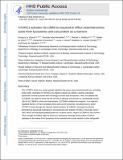mTORC1 Activator SLC38A9 Is Required to Efflux Essential Amino Acids from Lysosomes and Use Protein as a Nutrient
Author(s)
Freinkman, Elizaveta; Wyant, Gregory Andrew; Abu-Remaileh, Monther; Wolfson, Rachel Laura; Chen, Walter W.; Danai, Laura V; Vander Heiden, Matthew G.; Sabatini, David; ... Show more Show less
Downloadnihms915522.pdf (914.8Kb)
PUBLISHER_CC
Publisher with Creative Commons License
Creative Commons Attribution
Terms of use
Metadata
Show full item recordAbstract
The mTORC1 kinase is a master growth regulator that senses many environmental cues, including amino acids. Activation of mTORC1 by arginine requires SLC38A9, a poorly understood lysosomal membrane protein with homology to amino acid transporters. Here, we validate that SLC38A9 is an arginine sensor for the mTORC1 pathway, and we uncover an unexpectedly central role for SLC38A9 in amino acid homeostasis. SLC38A9 mediates the transport, in an arginine-regulated fashion, of many essential amino acids out of lysosomes, including leucine, which mTORC1 senses through the cytosolic Sestrin proteins. SLC38A9 is necessary for leucine generated via lysosomal proteolysis to exit lysosomes and activate mTORC1. Pancreatic cancer cells, which use macropinocytosed protein as a nutrient source, require SLC38A9 to form tumors. Thus, through SLC38A9, arginine serves as a lysosomal messenger that couples mTORC1 activation to the release from lysosomes of the essential amino acids needed to drive cell growth. SLC38A9 is an arginine-regulated transporter of major amino acids, including leucine, providing insights into the regulation of the mTORC pathway and its nutrient-sensing function. Keywords: amino acid sensing; nutrient sensing; mTOR; lysosome; micropinocytosis; autophagy
Date issued
2017-10Department
Massachusetts Institute of Technology. Department of Biology; Koch Institute for Integrative Cancer Research at MITJournal
Cell
Publisher
Elsevier
Citation
Wyant, Gregory A. et al. “mTORC1 Activator SLC38A9 Is Required to Efflux Essential Amino Acids from Lysosomes and Use Protein as a Nutrient.” Cell 171, 3 (October 2017): 642–654 © 2017 Elsevier Inc
Version: Author's final manuscript
ISSN
0092-8674
1097-4172